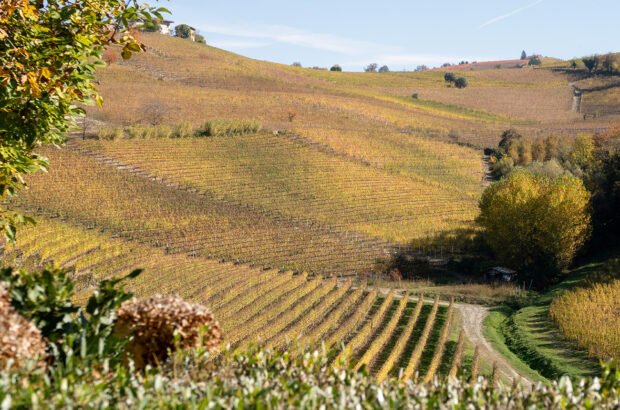For inimitable style, consistent quality and impressive value, rosé wine from Greece has the potential to become a category leader. Strange then to discover that, officially at least, Greek rosé doesn’t exist. Sete, the Greek Wine Federation, whose members produce 75% of the total volume of wine produced in Greece and export 95% of bottled Greek wine, has until now been counting rosé in with red wine, so it’s impossible to say exactly how much rosé is flowing from one of my favourite wine nations.
Scroll down for Olly Smith’s 10 Greek rosé wines to try
For certain, Greek wine is on the rise in the UK. For a second consecutive year, the Federation reports, exports to the UK exceeded €7 million, up by 57% on the five-year average. And the rise of rosé may prove a significant jewel in their crown.
Heart & soul
Scrubby Grecian hillsides fringed with herbs, pines and sea are perfectly suited to the production of everybody’s favourite poolside glass. On my annual pilgrimage to the Greek wine fair Oenorama in Athens earlier this year (next edition, 7-10 March 2025), rosé was unquestionably the major buzz. I tasted plenty of varietal rosés from local grapes such as Xinomavro, which tends towards summer fruit with a hint of sundried tomato, or Fokiano with its salty strawberry thrill. Blends commonly fuse a splash of red with fragrant whites such as Malagousia or Moschofilero, which lifts Greek rosé to the headiest refreshment.

Iliana Malíhin works with organic growers around Melambes in Crete. Credit: Iliana Malíhin Winery
There’s also heritage to consider. Take, for instance, Iliana Malíhin’s sublimely rich, lees-aged Liatiko Rosé 2022, harvested from Cretan bush vines. In 2019, at just 26 years of age, Iliana established her own winery on Vouvala mountain working with local organic producers around the village of Melambes. In 2022, wildfires tragically ripped through vineyards with some vines more than 140 years old and 95% pre-phylloxera. She tells me she made her Liatiko Rosé 2022 ‘because of the fire – it has the colour of the fire and it is my passion to bring every small plot of old vines back to life’.
Similarly, three and a half hours north of Athens in Meteora, I was awestruck by Theopetra’s vineyard, surrounded by ancient pinnacles of rock in a landscape created when a vast inland lake emptied into the Aegean. Monasteries and nunneries, built over centuries, are perched on the lofty peaks in a ring shape that shelters the vines, providing protection from the extremeties of weather – almost like a giant version of the kouloura vines woven at ground level across the vineyards of Santorini. Theopetra’s resulting rosé guards a lush fragrance with grip and zest that I still find as thrilling as the memory of this ancient, sculpted terrain.

Apostolos Thymiopoulos (see below). Credit: Aris Deliopoulos
Seriously appealing
Yiannis Paraskevopoulos of Gaia, based in Santorini and Nemea, insists that Greek love for rosé is nothing new. In fact, he says, ‘rosé is in our genes; Greeks always think of rosé when they think of wine’. And while most modern Greek rosé tends to be bottled in clear glass, showing off the colour and suggesting drinking rather than keeping, respected growers such as Apostolos Thymiopoulos are treating rosé with real reverence. ‘Rosé to me is a wine not a marketing tool, thus I respect it and bottle in a dark bottle,’ he says. Without question, Thymiopoulos’ remarkable Greek rosé has the capacity to age and if you’re already a fan of Bandol rosé, from Provence in southeast France, look no further than his Rosé de Xinomavro 2022, which will happily evolve with careful cellaring for a decade or more.

Yiannis Paraskevopoulos / Credit: Heinz Troll / Gaia
Street cred
While cult wine-growers impress wine fans with serious rosé via restaurants and independent merchants, thanks to the persistence of UK-based buyers such as Steve Daniel of Hallgarten Wines and Mary Pateras of Eclectic Wines, the presence of Greek rosé is also growing on the high street. Majestic’s Agapi by Kintonis, Greek Rosé 2023 is £9.99 at the retailer’s Mix Six price (£12.99 per bottle). It’s a joyfully summery blend of Roditis and Malagousia, with a dash of red Agiorgitiko, sourced from low-yielding, high-altitude vineyards in the Peloponnese. At £10, Marks & Spencer’s Myrtia Moschofilero-Assyrtiko Dry Rosé 2022 makes for a gently aromatic aperitif.
But my current top high street pick is Aldi’s superb Athlon Assyrtiko-Syrah Rosé 2023 (£9.99). I recommended it on BBC One’s Saturday Kitchen alongside a Mediterranean chicken cooked by Philli Armitage-Mattin, catapulting sales of the rosé by 124%. For the price, it’s a fresh and noteworthy champion of new-wave Greek rosé.
And perhaps it’s with food that the diversity of Greek rosé is at its most irresistible. Yannos Hadjiioannou, co-founder of London merchant Maltby & Greek, agrees that ‘most are fantastic as an aperitif but also have the body and structure to accompany a meal from start to finish’. In Athens wine bar Oinoscent I paired Gerovassiliou’s delicious Xinomavro Rosé 2023 (£25.34 Epinoia) with a dish of raw scallops laced with kumquats and citrus zest, which was one of the most invigorating combinations I can remember.
And over lunch at Skotadis on the island of Aegina, beside the harbour’s bobbing boats, I was struck by the simplicity and splendour of fresh prawns, lightly crisped and paired with the zing of Muses Estate’s A.Muse Rosé 2023. This smart blend of local red Mouhtaro with mostly Sauvignon Blanc is such a gem that I’ve listed it in my six Glass House wine bars across P&O Cruises.
Greece, albeit unofficially for now, is offering everyday drinkers as well as serious collectors a whole new realm of rosé to explore.












